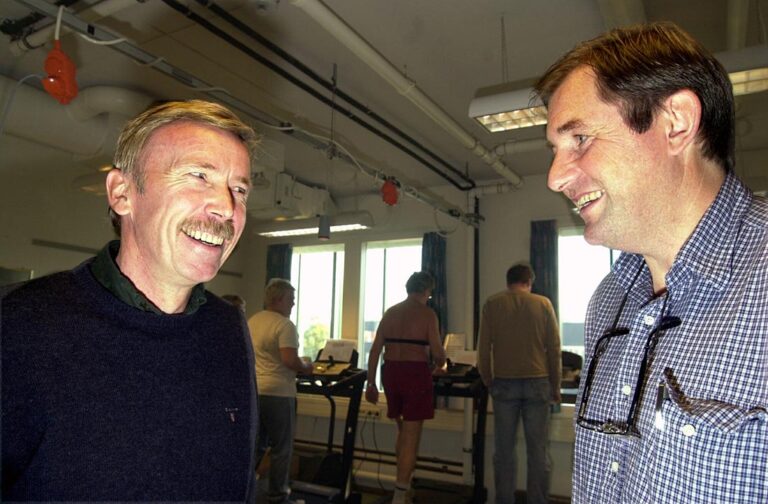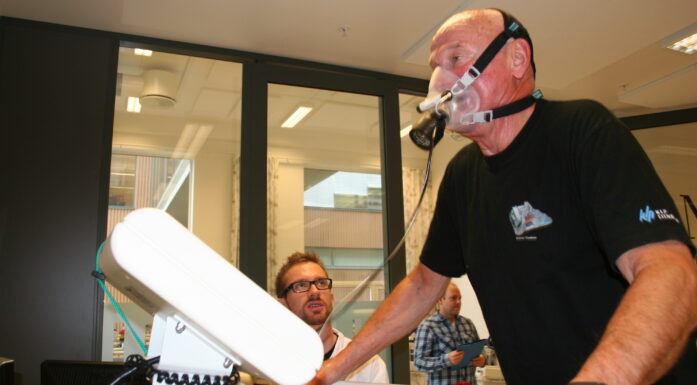4×4 interval training – popular and controversial
An easy way to better health, or gruelling toil that is also unbearably boring? Opinions about high-intensity interval training are many and varied.
“There are no studies that show that 4×4 interval training prolongs life more than any other type of exercise. However, there are studies showing that being physically fit is associated with more and better years of life,” says NTNU professor Ulrik Wisløff.
Too many of us are inactive. According to the Norwegian Institute of Public Health, only three out of ten people meet the authorities’ recommendations on physical activity.
One training method that is often presented as an effective way to ‘boost fitness’ is 4×4 high intensity interval training. Recently, NTNU professors Jan Helgerud and Jan Hoff published a book on interval training: 4×4 – Historien om de enkle og revolusjonerende intervallene. Shortly thereafter, researchers at Kristiania University College strongly criticised Helgerud and Hoff in the media, arguing that it was time for a final showdown with 4×4 interval training.
So, where does this form of exercise originate from, and why is it so controversial?
- You might also like: Seven weeks to reducing your belly fat
Effective cardio exercise
“4×4 interval training is not something specific to Norway and has been around for generations,” says Wisløff.
He leads the research group CERG (Cardiac Exercise Research Group), which through more than a hundred studies has investigated the effect of different forms of exercise on the body.

Ulrik Wisløff leads the research group CERG. It has laid the foundation for extensive use of the 4×4 method in the rehabilitation of, among other things, heart patients, both in Norway and internationally. Photo: Berre
They have shown how 4×4 interval training can reduce atherosclerosis in cardiac patients, how it can provide stroke patients with better balance and walking function, and how it can strengthen the heart and improve fitness in obese people – to name just a few benefits.
“Interval training is thought to be the most effective method of training the heart to pump lots of oxygen-rich blood around the body to the muscles. When this happens, fitness levels increase,” says Wisløff.
The reason you need to spend 4 minutes doing it and not just 1 is that it usually takes 2-3 minutes for the heart to start pumping at its maximum rate. If you stop before that, your heart won’t be exercised to the same extent. Alternatively, you can start with a long interval of 3 to 5 minutes, followed by shorter intervals with short breaks in between so that your heart rate doesn’t fall as much.
“4×4 is a simple method that is easy to remember, and experience has shown that most people can manage 4 minutes. But there are many other forms of exercise that have a similar or even better effect,” says Wisløff.
- You might also like: People who are in good shape take fewer mental-health related medication
From Finnish forests to Norwegian hospitals
We have to leave Norway to find the origin of 4×4 interval training. Finnish runner and Olympic champion Paavo Nurmi developed a form of interval training in the early 20th century, which was later adopted by German coaches at the University of Freiburg.
By all accounts, at the end of the 1950s, all world records from the 800 metres to the 10,000 metres were set by runners who did interval training.
In the 1990s, Hoff and Helgerud started working on introducing 4×4 interval training in Norwegian elite sports.
In 2004, NTNU researcher Øivind Rognmo was able to show that high-intensity interval training surpassed moderate-intensity exercise in increasing aerobic capacity in patients with coronary artery disease, where the blood supply to their hearts had been reduced due to narrowing or blockage of the blood vessels.
Today, even heart transplant patients are prescribed high-intensity interval training programmes when they’re discharged from the hospital.
In 2007, Wisløff and his colleagues published a study showing that high-intensity interval training produced good results in people who had suffered a heart attack. For the first time, it was shown that elderly patients with chronic heart defects and impaired heart function are fully able to perform high-intensity exercise.
The researchers also found that intensity was an important factor in improving heart function, blood vessel function and quality of life.
‘The Norwegian protocol’
The findings received a great deal of international attention.
“The results from CERG’s research have laid the foundation for several major international studies on 4×4 interval training for people with type 2 diabetes, coronary disease and heart failure,” says communications advisor and exercise physiologist at CERG, Anders Revdal.
The 4×4 method has also been successfully used by researchers in Australia, Brazil and several other countries. Several Norwegian hospitals have adopted the method in projects involving cardiac patients.
“In addition, both we and other groups at NTNU have published a number of articles that have investigated the effects that 4×4 intervals and other aerobic interval training have on healthy people, active and inactive people, young and elderly people, as well as in people with other types of lifestyle diseases such as metabolic syndrome, type-2 diabetes, obesity, rheumatic diseases, COPD and PCOS,” says Revdal.
“Internationally, 4×4 interval training is often referred to as ‘The Norwegian protocol’. The research on interval training has contributed to an increased focus on high-intensity exercise in both international and national recommendations on physical activity,” says Revdal.
- You might also like: Does it matter how long you sit – if you are fit?
U-turn
Today, even heart transplant patients are prescribed high-intensity interval training programmes when they are discharged from the hospital. In the book on the method ‘4×4 – Historien om de enkle og revolusjonerende intervallene’, medical professors Jan Helgerud and Jan Hoff write about their attempts to change a fundamental belief in the healthcare system that people should be cautious when it comes to exercise.
“It is completely natural that a person who has recently undergone heart surgery will be anxious about exerting themselves physically. But simply sitting still is the quickest way to die. It leads to other heart attacks – and death. If there is one thing we are really proud of, it is the widespread change in opinion that has taken place, and it all started here in Norway,” says Helgerud.
He believes that the small risk a heart surgery patient takes by being active is negligible compared with the risk associated with being inactive.
“This form of exercise is an effective method for treating serious illness,” says Helgerud.
In Norwegian guidelines for physical activity after having a heart attack and other coronary heart disease, 4×4 interval training is specifically mentioned as an example of effective cardio training.
Heart clinics in Norway and abroad use 4×4 interval training as part of the rehabilitation, and most fitness centres currently have 4×4 interval training on their workout programmes. Helgerud and Hoff call it the fountain of youth.
“It is actually a very simple method that many people try to complicate. Intensive interval training increases the heart’s capacity to pump blood. If you do two of these workouts each week, each session will improve your maximum oxygen uptake by half a per cent. If you do this for 10–12 weeks, you will have the same heart capacity as an average 20-year-old,” says Helgerud.
A simple method
According to the two researchers, otherwise spending a bit of time on the couch in front of the TV is not that dangerous. The point is that increased heart capacity reduces the risk of disease and enables a more active life, and then the rest will usually take care of itself.
“It is actually a simple method that many people try to complicate. You don’t need to sprint between lamp posts or buy expensive pulse watches. You can exert yourself by simply walking uphill. That is enough,” says Helgerud.

Medicine professors Jan Hoff and Jan Helgerud have been researching how the 4×4 method affects the heart and fitness for several decades. When NTNU celebrated its 100th anniversary in 2010, they were highlighted as one of the university’s success stories. Photo: Geir Otto Johansen/Aftenposten/NTB
The researchers believe that the notion that this form of exercise is too demanding is a myth.
“We have been criticised for encouraging people to exercise until they are exhausted, but we have had heart patients exercise in this way five times a week, for a month. It wouldn’t be possible if it had been that exhausting. The point is that fit people have to put in greater effort, while less-fit people achieve the same effect with a lower intensity,” says Hoff. In reality, they have exactly the same relative training intensity.
- You might also like: Keys to keeping your brain healthy
Easy to get bored
So, if it is such a great method, why is it controversial? At Kristiania University College, Professor Thomas Haugen is keen to present a more nuanced view of exercise.
“We believe it is wrong to prioritise one type of training session over all others. The best progress is achieved with different combinations of training sessions. The 4×4 method is an easy one to promote, but we mustn’t oversimplify to the point of dumbing down,” says Haugen.
For sedentary people, he is of the opinion that high-intensity interval training, i.e. 90 per cent of your maximum heart rate, a couple of times a week will be beneficial. For keen exercisers who work out 3-4 times a week or more, he believes it will lead to stagnation if other types of exercise are not included.
Variation in exercise is important, regardless of whether you exercise to keep healthy or are an elite athlete.
He refers to how elite athletes also use low or moderate intensity training sessions (about 85 per cent of maximum heart rate) as a regular part of their training. At a moderate intensity, you run or cycle at a level where you are able to get rid of the lactic acid your body produces.
You are able to speak, but only in short sentences. Elite athletes can often maintain these types of training sessions for 45 to 60 minutes. Low-intensity training sessions (approximately 70 per cent of maximum heart rate) can be maintained even longer, typically 1-2 hours.
“You can then keep going a bit longer, and it will be the length of the training session that has an effect,” says Haugen.
Back at NTNU, Wisløff believes that variation in exercise is important, regardless of whether you exercise to keep fit or are an elite athlete. However, he believes that training for 45-60 minutes at a threshold level will be too demanding for most people.
“Most people are unable to exercise for 45-60 minutes at 85 per cent of their maximum heart rate. We need to distinguish between elite sports and exercise for good health,” says Wisløff.
His experience is that 4×4 interval training can also be difficult to maintain over time.
“We also see that many heart patients who have been in rehabilitation stop exercising when their follow-up ends. 4×4 is easy, and I strongly believe in having some element of 4×4 in an exercise programme as it is time-efficient, but that doesn’t mean it is the only thing that works. We need to bear in mind that there are many alternatives and multiple approaches,” says Wisløff.
So what can you do to avoid getting bored after the initial enthusiasm wears off?
“I have written two books about that, ‘Superkondis – 14 uker til ditt livs toppform’ and ‘En ny start’, and at CERG, we have two 7-week programmes used by one million people around the world. Varied, free and good exercise,” says Wisløff.
Need exercise tips? Here is the CERG researchers’ exercise programme for people who need a new start – and encouragement to continue:
The 7-week programme – a 7-week journey towards better fitness and health
The next 7 weeks – continuing the journey towards a healthier life, better fitness, and lower fitness age







